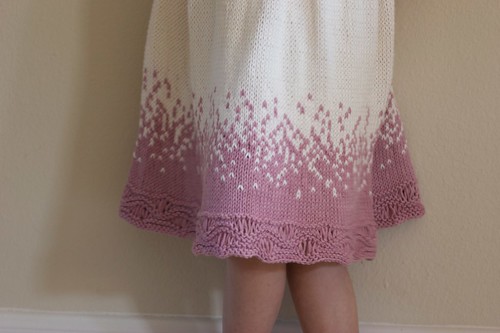I wanted to make a spring dress for my daughter and was inspired by cherry blossoms because that's one of my favorite trees. I love how the cherry blossoms gradually get darker and then rain down when it's time for the leaves to come in. I had admired Twinkle's Incredible Skirt and wanted to do that sort of color transition to simulate the white blossoms transitioning into pink and falling down. When I got to the colorwork, though, I found it hard to be random about which stitches were white and which were pink. I just couldn't make it look right. My wonderful (and nerdy) husband offered to do a quick Mathematica program to generate some random numbers for me. This was sweet, but besides the fact that it was hard to read (I'd have to keep track of my stitch count so that I'd know to make stitch #156 and #212 pink), I ran into the same kind of clustering problem that iPod users encountered. On some rows, it just so happened that there would be lots of one color all in a pile, making it look less random.
So what I decided to do was to make it pseudo-random. I decided, for example, that I wanted 1 stitch in the next 12 to be pink and the rest white. So I used the random number generator to pick a number from 1 to 12 for me. Whichever number came up would be the stitch that I'd make pink. Then I'd have the generator pick a new number for me and make that stitch the pink one in the next cluster of 12. The next row would have a pink stitch in each cluster of 11, then 10, etc. After a couple of rows of having an even number of white and pink stitches, the process was reversed.
If you've stuck it out this far in the post, then I really should show you some pics :-)


More pics and details on the rest of the construction are on Ravelry and in the gallery.
This is so pretty and unique. Lovely!!
ReplyDeleteIf there's one thing I love about you and your blog (and there are many more than one) it's the ease in which you convey your perfectionist thinking brain. I love it, perhaps because I understand it, and definitely because I admire it! And a helpful mathematical husband to boot..
ReplyDeleteAnd the payoff for such attention to detail is there in that skirt. Brava to you, it's gorgeous.
I got kind of lost when you started saying math, patternicity, cluster and stuff like that...but then I saw your pretty picture, now that I do understand! So pretty...really really pretty!
ReplyDeleteI know exactly what you mean...and it's one of those things that makes it difficult to present science and math to the public. If you want to be "good" about it, you have to keep it n mind and help people through the mindset. If you want to deliberately confuse matters, then you use this to your advantage.
ReplyDeleteUh...off topic much? But lovely dress!
It's a lovely skirt, and because it is pseudo-random, my first impression is that I see a pattern.
ReplyDeleteTrue randomness explains why I can suddenly lose tons of money at a casino because a losing streak can go on forever, even though I think it shouldn't!
That is PERFECT. The method of random worked. My eye sees the Brownian motion of floating blossoms.
ReplyDeleteThe sprinkling of pink and white at the bottom of the dress looks absolutely perfect to me! Well done.
ReplyDeletethat was the perfect solution! I LOVE the way the dress turned out. so perfect for spring
ReplyDeleteI love this little dress. But am not being able to get the pattern right on the bottom. The counts come out ok on 1 row, then the next they are all messed up. I don't know what happened!!! I think I will find a different pattern to put in it instead.
ReplyDelete